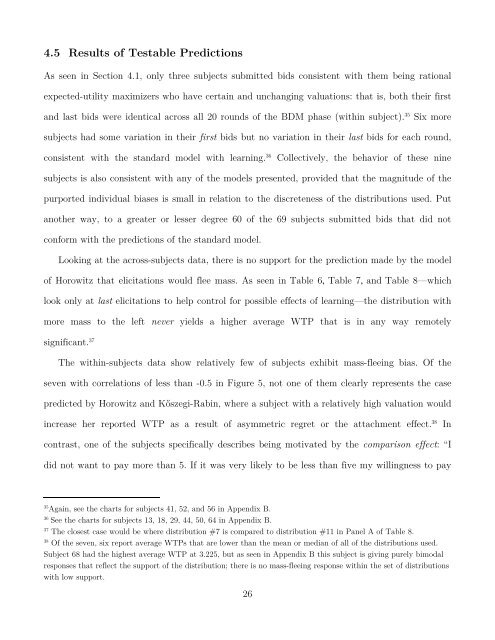Testing Distributional Dependence in the Becker-DeGroot-Marschak ...
Testing Distributional Dependence in the Becker-DeGroot-Marschak ...
Testing Distributional Dependence in the Becker-DeGroot-Marschak ...
Create successful ePaper yourself
Turn your PDF publications into a flip-book with our unique Google optimized e-Paper software.
4.5 Results of Testable Predictions<br />
As seen <strong>in</strong> Section 4.1, only three subjects submitted bids consistent with <strong>the</strong>m be<strong>in</strong>g rational<br />
expected-utility maximizers who have certa<strong>in</strong> and unchang<strong>in</strong>g valuations: that is, both <strong>the</strong>ir first<br />
and last bids were identical across all 20 rounds of <strong>the</strong> BDM phase (with<strong>in</strong> subject). 35 Six more<br />
subjects had some variation <strong>in</strong> <strong>the</strong>ir first bids but no variation <strong>in</strong> <strong>the</strong>ir last bids for each round,<br />
consistent with <strong>the</strong> standard model with learn<strong>in</strong>g. 36 Collectively, <strong>the</strong> behavior of <strong>the</strong>se n<strong>in</strong>e<br />
subjects is also consistent with any of <strong>the</strong> models presented, provided that <strong>the</strong> magnitude of <strong>the</strong><br />
purported <strong>in</strong>dividual biases is small <strong>in</strong> relation to <strong>the</strong> discreteness of <strong>the</strong> distributions used. Put<br />
ano<strong>the</strong>r way, to a greater or lesser degree 60 of <strong>the</strong> 69 subjects submitted bids that did not<br />
conform with <strong>the</strong> predictions of <strong>the</strong> standard model.<br />
Look<strong>in</strong>g at <strong>the</strong> across-subjects data, <strong>the</strong>re is no support for <strong>the</strong> prediction made by <strong>the</strong> model<br />
of Horowitz that elicitations would flee mass. As seen <strong>in</strong> Table 6, Table 7, and Table 8—which<br />
look only at last elicitations to help control for possible effects of learn<strong>in</strong>g—<strong>the</strong> distribution with<br />
more mass to <strong>the</strong> left never yields a higher average WTP that is <strong>in</strong> any way remotely<br />
significant. 37<br />
The with<strong>in</strong>-subjects data show relatively few of subjects exhibit mass-flee<strong>in</strong>g bias. Of <strong>the</strong><br />
seven with correlations of less than -0.5 <strong>in</strong> Figure 5, not one of <strong>the</strong>m clearly represents <strong>the</strong> case<br />
predicted by Horowitz and Kőszegi-Rab<strong>in</strong>, where a subject with a relatively high valuation would<br />
<strong>in</strong>crease her reported WTP as a result of asymmetric regret or <strong>the</strong> attachment effect. 38 In<br />
contrast, one of <strong>the</strong> subjects specifically describes be<strong>in</strong>g motivated by <strong>the</strong> comparison effect: “I<br />
did not want to pay more than 5. If it was very likely to be less than five my will<strong>in</strong>gness to pay<br />
35 Aga<strong>in</strong>, see <strong>the</strong> charts for subjects 41, 52, and 56 <strong>in</strong> Appendix B.<br />
36 See <strong>the</strong> charts for subjects 13, 18, 29, 44, 50, 64 <strong>in</strong> Appendix B.<br />
37 The closest case would be where distribution #7 is compared to distribution #11 <strong>in</strong> Panel A of Table 8.<br />
38 Of <strong>the</strong> seven, six report average WTPs that are lower than <strong>the</strong> mean or median of all of <strong>the</strong> distributions used.<br />
Subject 68 had <strong>the</strong> highest average WTP at 3.225, but as seen <strong>in</strong> Appendix B this subject is giv<strong>in</strong>g purely bimodal<br />
responses that reflect <strong>the</strong> support of <strong>the</strong> distribution; <strong>the</strong>re is no mass-flee<strong>in</strong>g response with<strong>in</strong> <strong>the</strong> set of distributions<br />
with low support.<br />
26


